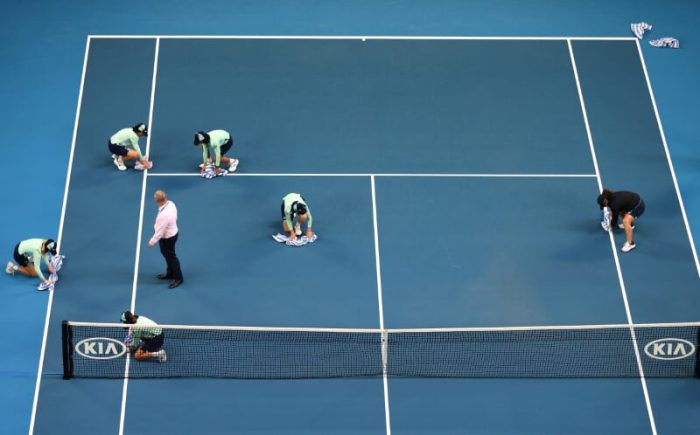The 2019 quarterback class has a consensus top four, but all four bring wildly different styles, skill sets, strengths, weaknesses — and opinions from evaluators.
Let’s dig into the “wows” and the “red flags” for each, starting with the likely first overall pick.
Kyler Murray, Oklahoma
Wow: Twitchiness as a thrower
His explosiveness as a runner is obvious, but Murray’s athleticism also translates seamlessly to his throwing ability. That sounds natural but is far from a given — just ask Blake Bortles or Paxton Lynch.
His sharp, active feet stay under him for balance but are always ready to move and reset for a new platform. Likewise, his arm is a whip that lashes out from any angle with a snappy release. Together, these tools help him throw extremely quickly from myriad positions with precision.
On the 10-yard touchdown against UCLA, Murray threw with just enough touch to get over the defensive line and the linebacker but also with enough zip to beat the cornerback. The ball placement was perfect. His tape is littered with throws like this.
Murray’s twitchiness also helps him stay on schedule even when forced to move early. On long touchdowns against Iowa State and Alabama, he had to move immediately after his play-fake but quickly reset from an unnatural platform to flick a flawless deep ball. In both cases, he kept the play on time despite immediate pressure — had he taken any longer, like most QBs would, his receiver would be too far downfield to hit in stride.
More than ever before, NFL schemers excel at creating simple reads and open targets for their quarterbacks. In turn, getting the ball from Point A to Point B with zippy precision — even amid adverse conditions — is a tremendously valuable skill.
Red flag: Inconsistent field vision and pocket movement
Murray’s hair trigger is important, because he is often a beat late to identify open receivers (and sometimes overlooks them entirely). His eyes aren’t as quick as predecessor Baker Mayfield’s, and they pinball at times instead of reading smoothly through a progression. Whether because of his short stature, Murray fails to see open receivers now and then.
Linked to inconsistent vision is a lack of polished pocket movement. Leaning on his athleticism, Murray often defaults to juke-and-escape mode — dropping his eyes at times — upon seeing/feeling pressure, rather than stepping up or sliding. That instinct can pay off with big plays, but it cuts both ways.
Murray will overreact to perceived pressure at times and rush unnecessarily, as seen on a third-and-8 against Baylor and his lost fumble against Texas. On the former, he scanned right past his running back — wide open up the seam against an overmatched linebacker — and an open receiver near the sideline. He scrambled and took a hit short of the sticks.
Against Texas, Murray juked himself into pressure while holding the ball loosely with one hand (a consistent tendency), creating his own fumble despite no rusher threatening until after he moved.
On third-and-11 against Alabama, Murray did a better job stepping up calmly, but his head bounced from left to right to left and back right again. He failed to spot a coverage bust to his left or anticipate a crossing route opening from left to right before he was sacked.
These aren’t all easy plays to make, but they highlight issues that will be exposed more often in the NFL. Murray had mostly terrific protection at Oklahoma, and the offense featured several half-roll concepts that moved the pocket slightly, slowing down opposing rushers.
If placed behind a porous offensive line early in the NFL, Murray will avoid some sacks and create big plays. But it also could exacerbate these issues, encouraging him to abandon reads and escape rather than refining his pocket movement and vision.
–Dwayne Haskins, Ohio State
Wow: Mental processing and field vision
A redshirt sophomore and one-year starter, Haskins’ lack of experience belies his advanced mental grasp of the game. Ohio State coordinator (now head coach) Ryan Day put a heavy burden on Haskins, shifting to more of a pro-style scheme with full-field progressions and asking him to set protections and change plays at the line of scrimmage.
Haskins rewarded him handsomely, showing quick eyes and processing, and finding targets late in the progression at a rate rarely seen from college quarterbacks.
These are high-level plays on obvious passing downs that many current NFL quarterbacks don’t make with regularity, but Haskins did so throughout 2018 and even more frequently late in the year.
The throw against Michigan State went to his fourth read, a backside dig, with perfect ball placement despite late pressure on second-and-14.
On third-and-7 against Northwestern, he stepped up smoothly from edge pressure — with both hands on the ball — before hitting his third read, throwing over a dropping D-lineman but with zip to beat the closing linebacker.
His touchdown against Washington was another fourth read. Haskins quickly eliminated covered routes to his right, scanned left — moving his feet with his eyes by sliding and stepping up — and layered a throw to the backside post on third-and-8. (Also notice, he signaled pre-snap to his slot receiver to run a hot route if the Huskies blitzed.)
Haskins also regularly uses subtle pump fakes and shoulder rolls to manipulate coverage, another high-level ability that some QBs never learn.
Recent history tells us the very best quarterbacks — Brady, Manning, Brees — win primarily with their minds. In just 14 career starts, Haskins has clearly shown the ability to do that.
Red flag: Response to pressure and inconsistent accuracy
Let your 16-year-old drive a Lamborghini long enough and he’s eventually going to crash it.
Day’s pro-style offense gave Haskins tremendous freedom, but it also allowed opponents to get more creative with blitzes, knowing they had time to get home as the quarterback went through full-field reads. TCU was the first to really stress Haskins with pressure, but he mostly responded well.
Penn State employed a similar blueprint with greater effectiveness, and Purdue and Michigan State followed suit, making Haskins uncomfortable and forcing misses or rushed decisions.
Facing repeated pressure in those games, Haskins’ accuracy went missing for stretches, even amid a clean pocket at times. His feet got lazy — a tendency he often overcomes with his arm — and his delivery rushed, leading to ugly misses.
At times, Haskins broke down in the pocket before pressure arrived and dropped his eyes to scramble, like against Penn State.
These issues are common for quarterbacks when pressured repeatedly — and outside of those poor stretches, Haskins’ accuracy was mostly razor sharp — but he will have to adapt to minimize negative stretches.
Whoever drafts Haskins will hope he improves at setting protections and finding answers against blitzes, trusting his mental acuity to win out as he gains experience. He also must sharpen his footwork and maintain it when pressured.
If not, Haskins’ coaches will be forced to protect him more through scheme — in other words, keep the Lamborghini off the highway. Nobody wants that.
–Drew Lock, Missouri
Wow: Arm talent and release
You’ve heard about Lock’s cannon by now, but his flexibility and speedy release are as valuable — if not more so — than his pure arm strength.
He overuses the sidearm slot, but Lock can whip the ball from funky arm angles like few outside of Patrick Mahomes, Aaron Rodgers or Matthew Stafford. Combined with a lightning release, he can be deadly.
Most of those throws were on-schedule to the first or second read, but as he showed on third-and-12 against Oklahoma State, Lock can occasionally conjure brilliance from nothing late in the down.
His quick delivery is also a weapon against blitzing defenses. A four-year starter, Lock earned the authority to audible at the line and used quick flicks to beat the rush for third-down conversions or explosive gains.
Notice against Florida how Lock saw the nickel cornerback communicating with the safety, anticipated blitz and signaled for his slot wideout to run a quick hitch. (The wideout nearly ruined the play twice, by false starting — no call — and then bobbling the throw.)
Given Lock’s tools and level of experience, it’s no surprise NFL coaches want to work with him.
Red flag: Inconsistent field vision and skittish pocket movement
However, Lock doesn’t read the field as sharply as you’d expect from a four-year starter.
While he occasionally works deep into a progression, his offenses were built on either-or reads from 2015-17. Missouri’s attack expanded in 2018, but Lock produced shaky results, and he never fully mastered some simple designs.
Even when presented open receivers on basic reads, Lock failed to pull the trigger at times.
On third-and-6 against Arkansas (in 2017), Missouri’s post/wheel concept worked exactly as intended, springing the tight end — the primary read — wide open. Lock stared at it but didn’t throw, instead scrambling into pressure (and committing intentional grounding).
On third-and-4 against Alabama, Missouri ran a mesh concept with a wideout screening for the running back on intersecting crossers. The back came wide open, but Lock stared at the wideout (covered by three Tide defenders) and never saw the back.
Tied to Lock’s inconsistent vision — and perhaps more worrisome — is an extreme lack of pocket toughness.
That’s not to say Lock won’t take big hits; he makes some great throws on tape while getting clobbered. But he shows an extreme aversion to pressure, which short-circuits his reads and promotes dangerously undisciplined pocket movement.
Lock drifts and fades with alarming frequency, relying on back-foot throws, even when pressure is not close. He rarely showed the inclination to step up or slide within the pocket. That won’t fly in the NFL, where quarterbacks must step up to prevent easy angles for pass rushers.
By drifting deeper, Lock repeatedly gave edge rushers a shorter corner to turn, hanging his offensive line out to dry. Against Oklahoma State, he broke a free blitzer’s attempted sack, but he should have stepped into a clean pocket much earlier, giving that rusher a more difficult path.
Lock did make progress as a senior, his first year in a remotely pro-style offense, but he has a long way to go. Given how difficult it is to teach and improve field reading and pocket toughness, he carries major risk.
–Daniel Jones, Duke
Wow: Pocket movement and toughness
A complete 180 from Lock, Jones has pocket toughness in spades.
Yes, Jones has clearly learned from QB guru David Cutcliffe to navigate the pocket with proper mechanics (active feet, two hands on the ball, eyes downfield, etc.). At the same time, he also has something you can’t teach — a willingness to sacrifice his body to maximize every play.
With a weak supporting cast at Duke, Jones faced tons of pressure: unblocked, off the edge, through the middle, and sometimes all of the above. He was willing to not only take hits, but also to move into more exposed positions seeking the best throwing platform.
The deep throw against Virginia Tech came less than three minutes into his first game back from a broken collarbone. Jones shuffled slightly left from one rusher and stepped into another, getting slammed by both, but his receiver failed to secure a gorgeous deep ball.
On third-and-13 against Miami, Jones saw the slot blitzer come free but didn’t let it affect his mechanics. He stepped up quickly and fired a dart for a first down.
On third-and-8 against Temple, he again stepped into a hit to get enough juice on a sideline throw for a conversion.
Red flag: Decision making
The play against Temple, however, also hints at a concern about Jones: He writes too many checks his arm can’t cash.
Jones’ arm strength isn’t poor, but it’s closer to average than good, and his delivery can border on being too methodical. He flashes a slight windup and rarely makes the quick-flick, multi-platform deliveries these other three quarterbacks do regularly.
That’s OK — some NFL starters have merely decent arm talent — but Jones too often plays with the recklessness of a stronger-armed passer. The throw against Temple wasn’t far from being intercepted, and his tape shows too many ghastly gambles.
As a Duke product working under Cutcliffe with connections to the Manning brothers, Jones often gets labeled as a cerebral signal-caller who dices defenses up mentally. But decisions like these show he has a long way to go.
While he works deep into progressions and makes sound pre-snap decisions at times, it’s difficult to excuse late-down-the-middle throws like the one against Virginia Tech (which three different defenders could have intercepted).
The dropped pick near the sideline vs. the Hokies is even more concerning. On a very simple two-man route concept, the out route opened immediately, but Jones stared and waited. His receiver reached the numbers before he began his throwing motion, late enough for the cornerback to close 5-plus yards of separation. (The throw was also too far inside).
Unless he strengthens his arm or quickens his release, Jones must play more conservatively to survive in the NFL. Compensating for less-than-ideal tools requires maximizing mental precision and minimizing poor decisions.
–David DeChant, Field Level Media

















